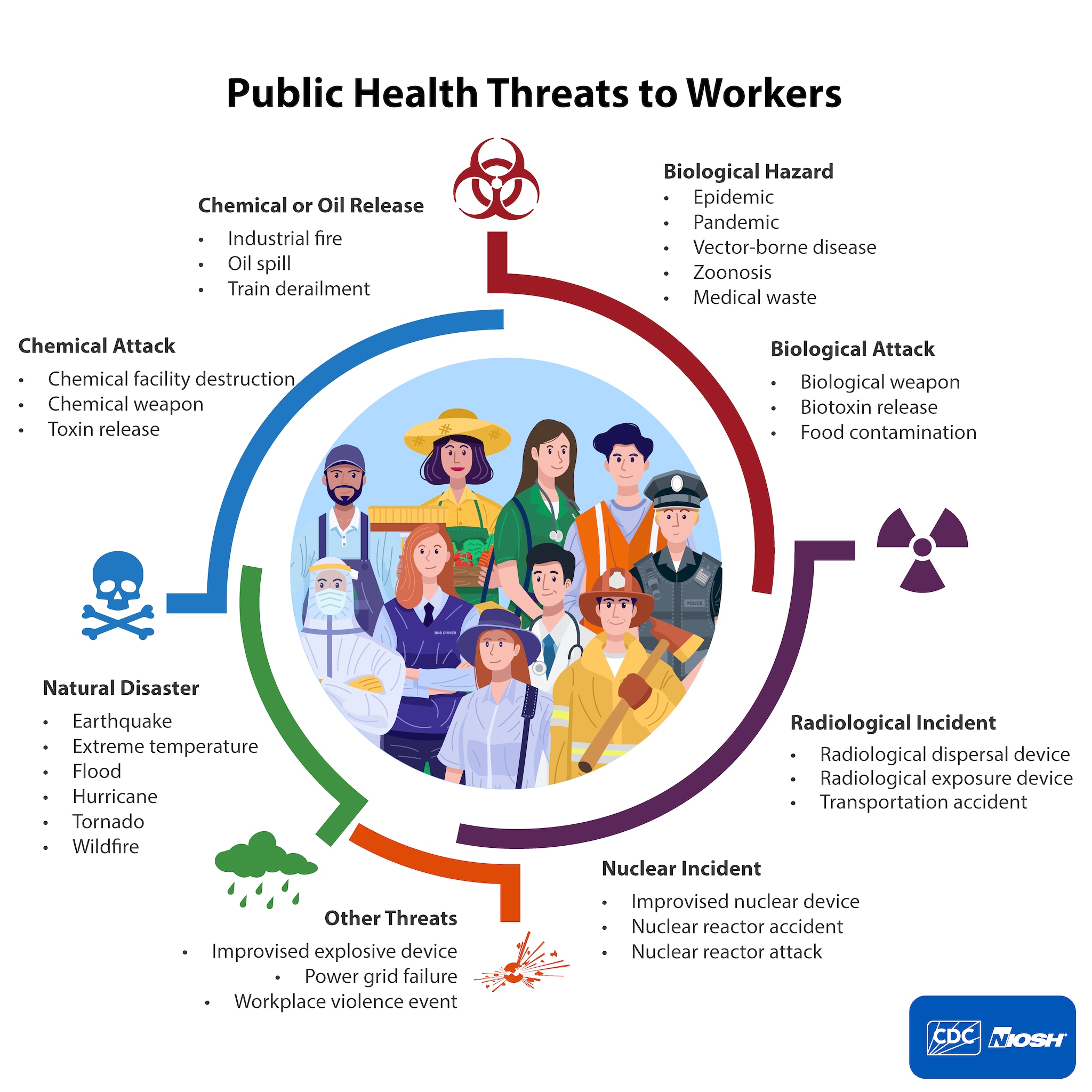Key points
- The Disaster Science Responder Research (DSSR) program promotes quality data collection and research to improve health among workers impacted by public health threats.
- The DSRR Strategic Framework provides evidence-based approaches to inform priorities and mitigation strategies and to develop occupational safety and health recommendations.
Overview
The DSRR program develops novel and reliable approaches for collecting scientific data and conducting real-time surveillance and research during public health threats (PHTs). The program also identifies research to be performed outside the scope of an emergency to protect workers in the future. The program worked to identify and evaluate strengths and gaps, incorporate lessons learned from recent responses such as COVID-19, and create goals and objectives for the future. The Strategic Framework will continue to evolve as the program adapts to meet future occupational safety and health demands for workers.
In this framework, a PHT may include disasters such as infectious disease outbreaks, chemical spills, and natural disasters. A PHT can include anything from a small-scale to a large-scale incident involving multiple jurisdictions and federal agencies. Workers impacted by a PHT may include healthcare personnel, first responders, public health personnel, meat and poultry processing workers, farm workers, airline and airport personnel, public transportation operators and other passenger drivers, grocery and food retail workers, volunteers, and delivery drivers.

An internal NIOSH steering committee consisting of scientists with varied subject matter expertise supports the DSRR program and created this framework. Their wide-ranging expertise ensures the program can address multiple topics including:
- Economics
- Engineering controls
- Environmental exposure assessment
- Epidemiology
- Clinical interventions
- Implementation science
- Injury
- Mental health
- Personal protective technology
- Risk assessment
- Surveillance
- Workplace violence
- Zoonoses
Background
Workers impacted by PHTs often perform non-routine activities in uncharacterized, hazardous environments. They may encounter novel exposures or experience unexpected health effects, injuries, or impacts on mental health. These are in addition to the expected exposures based on routine PHTs, such as weather-related threats. There is frequently a pressing public health need to answer critical questions regarding the impact of PHTs and to determine the factors responsible for adverse health effects experienced by workers, whether acute or chronic.
Reliable scientific information is critical to emergency preparedness and response efforts, while protecting workers requires developing and using scientific information effectively. Multiple entities must coordinate to collect and disseminate high-quality data in a timely manner.
Occupational safety and health research in the PHT environment should consider and address many unique challenges. These challenges include the following:
- The urgent nature of critical response activities, capabilities, and resources
- The safety of the team members conducting studies and study participants working in hazardous environments
- Rapid access to emergency response leadership, such as human subjects research Institutional Review Boards (IRBs), who will need to approve research protocols
Mission
The mission of the DSRR program is to provide quality data and evidence-based recommendations to decision-makers to guide approaches for collecting data and conducting research, and to create mechanisms for overcoming the associated logistical, technical, and administrative challenges encountered during a PHT.
DSRR Program Principles
- Protect Workers: Ensure safety, health, and well-being for workers impacted by PHTs in their workplace or where they live through strategies informed by readiness and response science.
- Elevate Science: Contribute to readiness and response science by working with extra- and intramural partners to advance relevant research, data collection systems, evaluation, and implementation activities.
- Leverage Technology: Improve real-time situational awareness through the development and use of technology best suited for assessing and protecting workers from the occupational safety and health hazards associated with the response to and recovery from PHTs.
- Address Gaps: Decrease disparities among traditionally underserved workers impacted by PHTs through mitigation strategies informed by a variety of scientific disciplines.
- Improve Communication: Translate scientific research into practical recommendations and accessible communication materials to inform occupational safety and health decision making and training needs.
Goals and objectives
Despite the growing awareness of the variety of ways that PHTs may impact worker safety and health, critical gaps remain in our understanding. Strengthening the base of scientific evidence- through research will allow the DSRR program to inform priorities and mitigation strategies and to develop occupational safety and health recommendations.
- Goal 1: Identify and prioritize critical science and research needs for assessing and protecting workers impacted by PHTs.
- Identify and foster partnerships and dialogue with interested parties.
- Identify science and research needs that can be conducted both during and outside the scope of a response.
- Identify and foster partnerships and dialogue with interested parties.
- Goal 2: Address major challenges associated with conducting research during and outside the scope of disasters.
- Identify and address logistical challenges—such as rapid acquisition and deployment of resources and data security—in conducting research during a PHT.
- Implement strategies for rapid data collection and rapid IRB protocol approval.
- Identify and address logistical challenges—such as rapid acquisition and deployment of resources and data security—in conducting research during a PHT.
- Goal 3: Identify existing surveillance systems, data collection tools, and other information resources that can be utilized for occupational safety and health concerns related to PHTs and identify where gaps exist.
- Identify and compile potential data collection tools, capabilities, and information resources commonly used during responses.
- Identify and develop occupational safety and health data collection tools where sources are lacking.
- Identify and compile potential data collection tools, capabilities, and information resources commonly used during responses.
- Goal 4: Ensure the dissemination of research findings and lessons learned reach the impacted employers and employees of concern.
- Publish key research findings and disseminate results to maximize impact.
- Ensure utilization of the research results from past response efforts to help inform future disaster research and response effectiveness.
- Publish key research findings and disseminate results to maximize impact.
